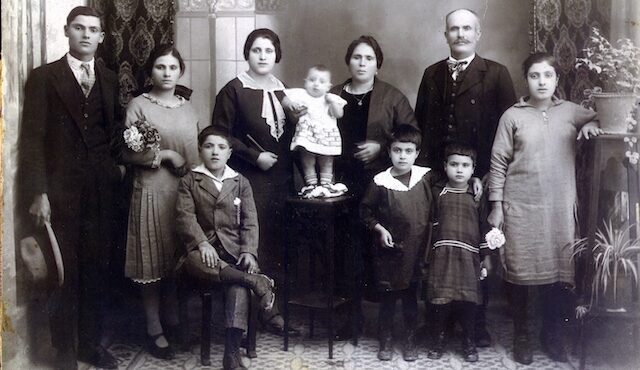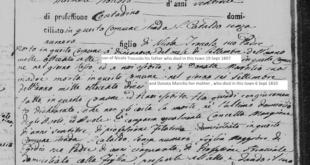Last month, we discussed how the Italian naming traditions can be used to help create the entire family tree more easily. You can guess the names of grandparents and search for marriages of people with the correct first names without even knowing them from an official document, just because they have grandchildren with those names. Also you can tell which children were alive and when, based on how the later children were named.
We also started talking about stillbirths, mostly because they fill out the family and you can then say that you have a complete family tree.
When I was in Italy in 2003, I met our cousin Dott. Nicola Santoliquido, who was a college professor and also one-time Mayor of Triggiano in the 1970s. Very nice man. He spoke no English but explained to me (who spoke no Italian) that his grandparents had “quattro figli; Annangela, Michele, Marianna and Orsolina”. Yes those were the siblings I knew about: Michele came to America several times but did not stay, and the other three came to Chicago and died here. But having researched the entire family in the Italian records, I was able to say to the professor “in realtà i figli erano nove, non quattro”. And I proceeded to show him birth and death records of five more children who unfortunately failed to survive to adulthood. Two of these five children were twins. I hoped I would not offend this learned man by correcting him. He had a look of shock, followed by happy surprise. He had always wondered why there were twins in his family, and I unintentionally solved that mystery for him.
When someone is new to genealogy, it seems a better start to trace your ancestors and go backward. This typically only gives you two parents, four grandparents and eight great-grandparents. But we all know that was usually not the entire family structure, especially in Italy in the 19th century. If both the father and mother lived at least into their 40s, there could be 8, 10, 12 or more children. I would guess that most Italian families are like my great-great-grandparents, with 4 children we knew, and 5 we didn’t.
It makes sense to look for all children of a family. If you think of your mother or father, you probably think of your aunts and uncles and cousins. You knew these people. But from a century ago, you might not know all the children, and there’s no one to ask, regarding a family so far back. So you will need to go through the records going forward and try to find all children of a single family.
The best way to start is to have the marriage record of one set of ancestors in Italy. Nicola Santoliquido and Maria Lucrezia Olivo married in 1878 in Triggiano. Not only does this marriage give you the names of their parents, but it gives us a starting point to find all the children moving forward.
So if a couple married in 1878, what year should you start looking for their children? It is usually a safe bet to check the birth records starting with the year of the marriage. I know you can say “oh yeah, they married late in the year and shouldn’t have any “premature” children, but it won’t take that long to check one extra year.
And yes, you will sometimes end up finding children born 5 months after the parents were married. Sorry.
So what is the process of finding every child? It depends on the birth records and the index. Each year will have its own index, or not.
- Start with the year the couple were married.
- Is there an index to the births for that year?
- If there is no index, then you have to scroll through all births for that town and that year one at a time. Look in the left for the surname.
- If there is an index, does the index show the names of the parents?
- If it does (usually pre-1865), then you only need to look for the children of that one couple. Much easier. Write the name of the child, and birthdate.
- If it only has the names of the children in the birth index, you will need to write the names and sequential birth numbers of each child with the surname you need.
- Go to each record in that year that you wrote earlier, and confirm whether it has the correct parents. Make a copy or snap a phone photo since you’re here.
- Make sure there are no twins for the person you found.
- Go back to step 1 for the next year.
Let’s discuss some of these steps. If you have no index at all, you may have to scroll through dozens or even hundreds of records, but you can quickly skip anyone who had the wrong surname. If they have the right surname, check the parents. It might be another family. You can decide for yourself if you want to keep track of everyone in town with the same surname. I do not recommend it for beginners.
If there’s an index, you may have written a dozen names and sequential numbers from the index. Now you have to scroll to each of those numbers. Check the parents. You may not find any children for that family for that year. Don’t be surprised.
If you do find one, should you check the rest of the names? Or can you jump at least 9 months ahead? My suggestion, even though it is extra work, is to keep looking, even though biologically you are very unlikely to find more children that year. You can get familiar with other couples who have the surname and it will be helpful later if you have to research those families.
What you should probably do is to keep a notebook, and write the names of each couple. At least record the name of the child and the sequential number, and the date if you found it. Then you’ll have a quick way to construct these other families if needed.
You could easily say “The kid was born in July. There won’t be any more kids in 1879.” This would save time, sure. But where do you draw the line? April? Could you have a couple with a child born in April and another in December? Unlikely, but technically possible. The December baby might have been born dangerously premature and died. You need to know that, so I suggest you look anyway. Anyone who has heard the phrase “Irish Twins” will soon learn there are Italian twins too, with one sibling born in February and one in November of the same year.
So you should finish the year and repeat the process for the next year. So how do you know when to stop? My great-great-grandparents married in 1878. Do I go to 1900?
You need to decide this based on what you may know. I happen to know that “Zi Zi Deline” was the baby of this family and was born in 1902, so I must search at least that far forward. If you don’t know anyone except the birth year of the ancestor who was born to this couple, then you can use other information.
- How old was the mother? Her age will be on the marriage. She could conceivably (no pun intended) keep having children into her 40s.
- Do you have a death notice for any sibling in this family? You might find names that you never heard before, and you ought to keep looking for births until you find all of the siblings listed in the death notice.
- If you go several years without finding children to this couple, there are several possibilities:
- The father might have died. Is the most recent child named for the father? Maybe you need to check the year before that baby was born to find a death for the father.
- The mother might have died. Check deaths starting the year of the birth of the most recent baby and work forward.
- Either or both parents might have emigrated to America permanently. Check a census record to see if any of the children of this couple was born in America. If so, you need to look for American birth certificates instead of Italian ones.
- The father might have emigrated to America temporarily. Look for a passenger list. At least you know they couldn’t have more children while living on different continents.
- As explained in last months’ column, there may be stillbirths that are not in the index under the correct surname. They may be listed in the index under “B” bambino non viva” and you may have to check each one, looking for the parents.
This is a lot to process. The good news is that the process is basically repetitive, and as long as you find children that belong, you’re making progress. Let’s stick to finding births for now. When you get adventurous, you can try the same process in the death records. It will work basically the same. Start with the year of the birth of the first child and work forward. You may not find deaths for A) children who were stillborn – that info will be on the birth record; and B) if any sibling stayed in Italy and died there of old age and you had no idea.
Happy Hunting!
Write to Dan at italianroots@comcast.net and please put “Fra Noi” in the subject, if you have any questions.
 Fra Noi Embrace Your Inner Italian
Fra Noi Embrace Your Inner Italian







